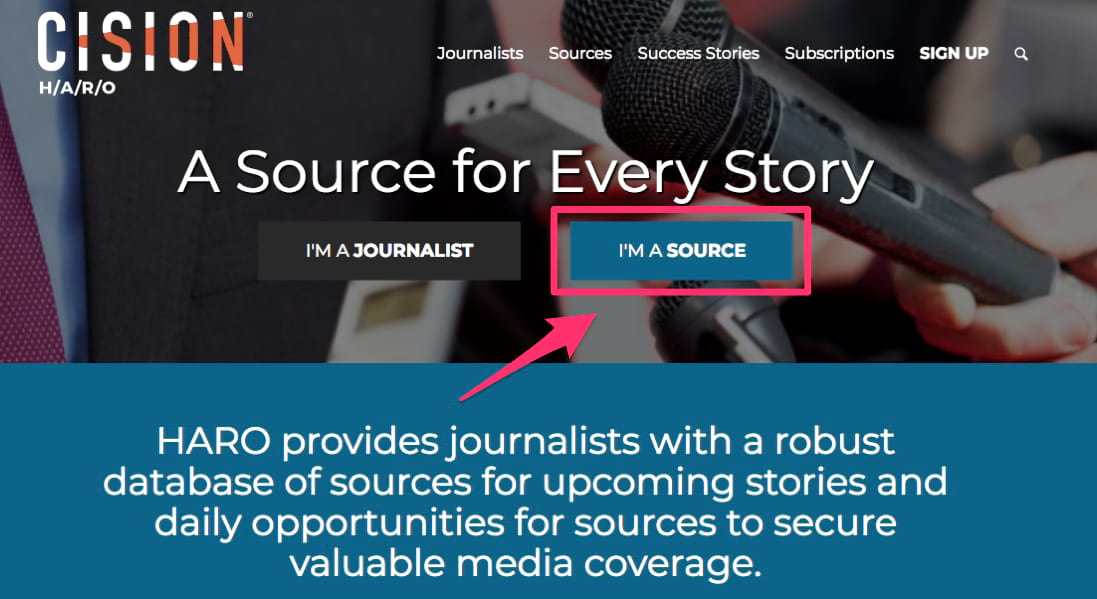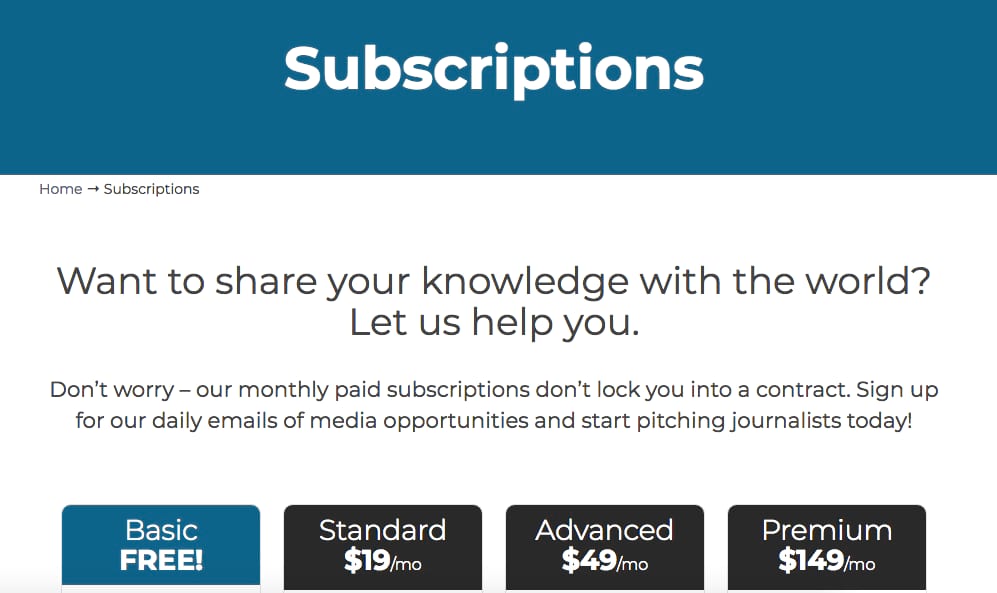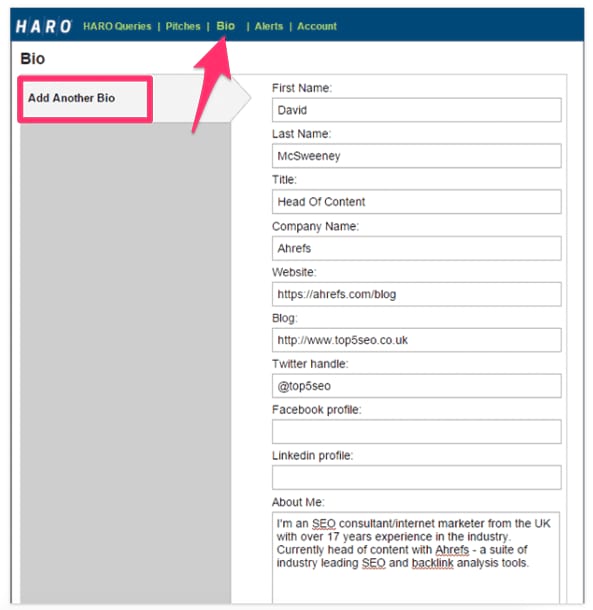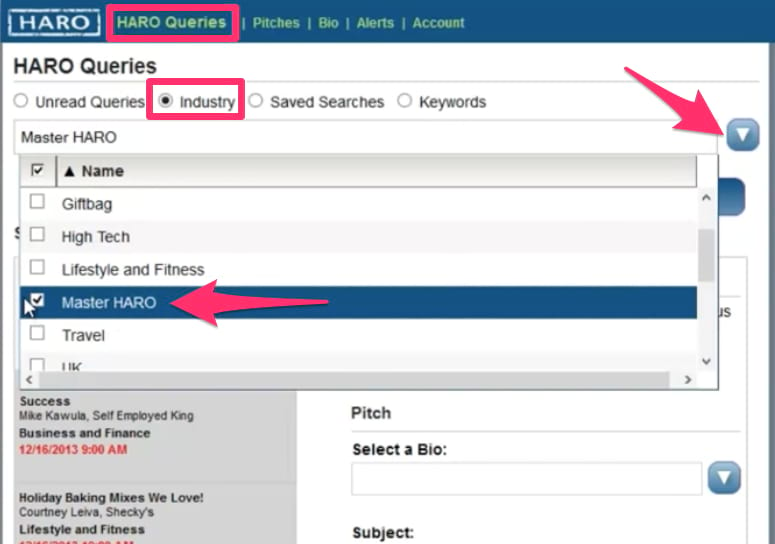Everyone wants more exposure for their brand and website. The benefits of increasing brand awareness and driving more website traffic speak for themselves.
Sometimes, this process can be slow, painful, and somewhat ineffective. But in my experience, that only happens when people don’t know where to look for authority links.
Once you’re able to get links on the right platforms, your exposure and site traffic will increase exponentially.
In order to be successful with this strategy, it’s ideal if you find ways to get featured on major digital media publications like The New York Times, Wall Street Journal, Time Magazine, Mashable, the Chicago Tribune, Fox News, and more.
But just individually reaching out to sites like that is not an effective use of your time and resources. So how can you get brand mentions on these platforms? Enter HARO.
What is HARO?
The acronym stands for Help a Reporter Out. It’s comparable to a dating website that connects journalists with people like you who want to be featured on major media sites. HARO has an extensive network of more than 55,000 bloggers and journalists connecting with over 800,000 sources.
For those of you who are ready to take your link building strategy to the next level, I’ll explain everything you need to know about leveraging HARO for brand exposure.
How HARO works
For those of you who aren’t familiar with HARO, the platform is very straightforward.
Journalists need sources for their news stories. So they join HARO to put in requests about certain topics. The requests include a brief summary of the story, source qualifications, and a pitch deadline.
When you join HARO as a source, you’ll receive three emails each day, Monday – Friday.
- 5:35 AM EST
- 12:35 PM EST
- 5:35 PM EST
It’s up to the sources to monitor these emails for topic requests that align with their own qualifications. If a source sees something that they qualify for and are interested in helping out with, they can reply to the email with a pitch.
Once a pitch is accepted, the source will be connected with the journalist writing the story to provide insight for the article. As a result, sources get mentioned along with links to their website.
Create an account
You can’t use HARO from a guest profile or anything like that. In order to take advantage of this brand exposure and link building strategy, you’ll need to start by creating an account.
So head over to their website and sign up as a source.

For the purposes of link building, it’s important that you sign up as a source as opposed to a journalist. Even if your website does some type of reporting, you’ll still need to have a source profile to get the links you’re looking for.
Signing up is very easy. All you need to provide is:
- First name
- Last name
- Email address
- Phone number
- Country
- Company name
- Annual revenue
- Create a password
The whole process takes a minute at most. So don’t be turned off by the fact that HARO forces you to create an account in order to participate.
Review the rules for sources
The list of HARO rules isn’t an outrageously long agreement terms form that you just blindly scroll through and click “I agree” without actually reading it.
It’s actually pretty quick to go through all of the rules, and it’s definitely in your best interest to do so. Why?
HARO has a pretty strict policy for violating their terms.
The first time you violate HARO rules you’ll be sent a warning. But your second violation results in being permanently banned from the platform. That’s it. No questions. No exceptions. No explanations.
The whole reason HARO works is because it’s based on trust between reporters and sources. Otherwise, journalists just wouldn’t use the platform.
I’ll take a moment to briefly summarize the rules, just to give you an idea of what to expect.
You’re only allowed to reply directly to the anonymous email requests from HARO. Don’t try to figure out who the journalist or publication is and contact them directly outside of the platform.
Do not spam journalists with pitches that aren’t related to their request. For example, let’s say you’re an animal expert. If you see a request related to fitness and personal training, don’t reply to the email discussing your animal knowledge. That would be considered a violation.
You are allowed to forward requests to others via email or social media. In fact, HARO actually encourages this, since it grows their network and helps out reporters (pun intended). So even if you don’t meet the qualifications of a request, feel free to send it to someone who does. They’ll just need to create a HARO account if they don’t have one already, and then they can submit a pitch.
Harvesting reporter information is strictly prohibited under the HARO guidelines.
All replies must be complete, direct, and relevant. Always include your bio and contact info when you reply to a request.
Don’t get off track by working a separate pitch into the reply. “Hey, I can definitely help you out with this story. But I’m also an expert in these subjects if you need it in the future…”
Messages like that are not allowed. You’re also not able to send any attachments with your email. Instead, use services like Dropbox links if you have supplemental info for your pitch.
This should go without saying, but you always need to be polite, respectful, and professional when dealing with anyone who is part of the HARO network.
If you follow all of these rules and guidelines, it increases your chances of having success and connecting with journalists via HARO.
Choose your plan
Once you’ve created an account and reviewed the rules, it’s time to pick your subscription. HARO offers several different plans to choose from based on your needs.

Here’s a brief overview of what you can get with each subscription. But for the most part, the majority of you would benefit from the standard plan. With that said, it’s definitely in your best interest to review all of the options to make sure.
Basic
Without paying anything, you’ll still get three emails each day from HARO.
The basic plan also comes with email support if you have any problems, questions, or need to contact someone.
With the free plan, everything is very straightforward. You don’t get any extra benefits or add-ons.
The free option is suitable for those of you who are willing to sort through lots of emails. You’ll probably get tons of emails that aren’t really relevant to your brand. But there are still plenty of opportunities for you out there. You’ll just have to do some extra leg work and sorting to find them.
Standard
For $19 per month, the standard plan comes with everything included in the basic plan.
Additionally, you’ll also get keyword alerts. Choose one keyword that’s related to your brand that will help filter the opportunities sent to you.
With the standard plan, you’ll also get to create a profile that you can insert into your pitches automatically. This will save you a tremendous amount of time compared to doing this manually for each individual pitch.
You can also sign up for text alerts in addition to email messages. The standard plan allows you to search for active requests online, instead of just waiting and sorting through emails that come in.
As I said before, this is probably the best option for most of you.
Advanced
The advanced HARO plan costs $49 per month.
It comes with everything included in the standard plan, but you’ll get extra keyword alerts. If you subscribe to this option, you’ll get to choose three keywords compared to just one. Furthermore, you can also create three separate profiles.
This is ideal for those of you who are well-rounded or have multiple people at your company that qualify as experts in different subjects.
For example, I might create a profile about digital marketing, another related to SEO, and a third about content creation. That way each profile could fit more specifically with certain requests from journalists.
The advanced plan also gives you a head start over other subscriptions. You’ll be contacted first whenever there is a new request. That extra lead time gives you a chance to craft and submit the perfect pitch before other sources in the network, which is a huge advantage.
Premium
For $149 per month, the HARO premium plan is the cream of the crop.
In addition to having everything included in the advanced plan, you’ll be able to set up an unlimited amount of keywords and unlimited profiles.
Phone support is available as well, as opposed to just email support. If you want the best of the best, this is the plan for you.
While the premium plan is obviously great, I don’t know if it’s necessary for most of you to pay nearly $1,800 annually for this. You could get a better value from a less expensive plan, but I’ll leave that decision in your hands.
Create a bio
One of the biggest advantages of paying for a subscription over the free account is the ability to have a bio section.
Whenever a journalist submits a request for sources, they get bombarded with pitches. It’s difficult for them to sort through all of these. Having a bio helps you stand out from the crowd and makes it less likely that your pitch will get lost in the shuffle.
Here’s a great example of a bio from David McSweeney at Ahrefs.

If a journalist sees this bio, they’ll definitely be more inclined to use David as a source.
As you can see, the team at Ahrefs has plan higher than the standard option. That’s because they can add another bio.
If you have multiple positions or team members who can contribute, you may want to consider upgrading your plan. For example, your CFO and HR manager will have different qualifications and areas of expertise. So you can use one bio over another based on the request from a reporter.
Unless you’re a big name in your industry, most journalists probably haven’t heard of you. It’s not in your best interest if they have to ask who is this person? Instead, let your bio tell the story for you.
Search and pitch
As I said earlier, if you pay for a subscription you don’t just have to sit back and wait for emails to come in throughout the day. You can actively search through reporter requests.

By default, you’ll see the master HARO list. But you don’t want that. Chances are that 90% of these requests won’t be relevant to you and your brand.
So click the downward pointing arrow on the right side of the screen, as I highlighted above.
Select the industry search option and uncheck the master HARO list. Then, check a category that’s more relevant to your niche. You can also search for requests with keywords. This will give you much more relevant search results.
After you find a request that fits your qualifications, it’s just a matter of pitching yourself.
Be quick, but informative. Remember, reporters are going to be sorting through dozens of these replies. To stand out from the crowd, you need to get your point across in a way that’s clear and concise.
They aren’t going to sit there and read long-form bulk paragraphs of rambling. Master the art of storytelling.
Show them that you actually read their request and you’re not just sending generic mass replies to every request. Provide them with a useful quote or two if that helps your case.
It’s also important to make sure that your pitch is grammatically sound.
Proofread everything before submitting it. Make sure there are no spelling or punctuation errors. These are journalists you’re dealing with. Mistakes can make you appear unprofessional.
Don’t use slang or go overboard with industry-specific terms in an attempt to impress the reporter. They may not know what you’re talking about and end up choosing someone else as their source.
Conclusion
HARO is a great way to build high-quality backlinks.
Using a network like this is much easier and more effective than pitching yourself directly to individual news sites and publications.
Instead, just wait for a reporter to submit a relevant request to your niche. Then follow up with your pitch through this platform.
This is your best chance to get featured on major authority sites that will grow your brand exposure and drive more traffic to your website with links.

